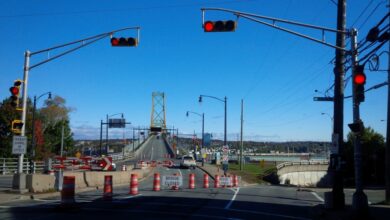The fight for proper pedestrian infrastructure in Halifax continues

Marooned bus stops. Access roads with no sidewalks. Pedestrians forced to walk alongside moving traffic. Safety advocate Martyn Williams is a witness to all of this as he documents the lack of pedestrian infrastructure throughout Halifax that puts people’s lives at risk daily.
Williams has been highlighting sidewalk issues across the city on his social media page, Safe Kjipuktuk. He also sends emails to the city and relevant businesses regarding poor pedestrian infrastructure.
It’s an uphill battle, of course. Responses from the city and businesses alike can take anywhere from a couple of days to several months—even longer for a solution to be enacted. Williams has seen some positive outcomes from this advocacy, though.
His most recent success came from contacting Choice Properties, a real estate investment fund and a subsidiary of Loblaws, which owns an access road on Chain Lake Drive connecting to the Bayers Lake Business Park. A glance at the road will make the issue obvious to most—the sidewalks near the lights cut off as they come up the access road, with only a thin pathway of gravel for pedestrians. Mobility scooters, strollers and wheelchairs have no choice but to leave the path, sharing the road with oncoming traffic.
Having walked it himself, Williams knows how terrifying the access road could be.
“At the moment, they’ve kind of marked out these three lanes so that when there is a vehicle in each of the three lanes, you’re really squeezed to the sides, and you feel ultra-vulnerable,” he says. “It’s like a vehicle just going towards you, and you’re not quite sure where they’re going to go to avoid hitting you.”
Williams captured photos of pedestrians walking alongside traffic on the access road and sent them to Loblaws, informing them of the issue and suggesting the company implement barriers for pedestrian safety until a sidewalk can be put in. After a phone call with a representative of Choice Properties and multiple follow-ups to ensure a solution was being devised, Williams got word that the company had a plan.
Nicole Vicano, vice president of retail asset management with Choice Properties, said in a July 29 email to Williams that the team had concocted a “comprehensive plan to enhance pedestrian access,” which includes laying down new asphalt and an accompanying sidewalk. Vicano estimated the project would commence by the end of the summer and would take four weeks to complete.
Choice Properties
Choice Properties, who owns the access road connecting to the Bayers Lake Business Park, say they plan to lay down new asphalt and install a sidewalk for pedestrians. Construction could begin at the end of the summer.
While this can certainly be considered a success, it comes with the caveat of having no temporary solution in the meantime. Williams wanted barriers erected to protect pedestrians in the meantime. He recommended this to Choice Properties; Williams says they told him that barriers could end up damaging people’s vehicles.
“On an access way like that, you could close down a whole traffic lane, one of three, put plastic barriers up, and it would be as simple as that, really,” he says. “It’s just, to me, it’s really shocking that really obvious health and safety dangers when it comes to pedestrians and vehicles—it’s like there’s a kind of blank spot in the mind of people, and they talk about seriously damaging vehicles instead of people.”
Susie Lake Crescent
Williams also documented a bus stop on Susie Lake Crescent with no connecting sidewalks—rather, pedestrians have to either walk down over a hill from the nearby parking lot if they’re able or walk alongside moving vehicles to a dirt path next to the stop, created by years of foot traffic. He emailed a photo of the stop to Halifax 311 in November 2023, recommending the city reallocate road space for pedestrian use until a long-term design change can come into effect.
While the city documented his complaint, no solution has yet to be enacted in that area—however, a customer service advisor with Halifax Transit assured Williams that HRM’s active transportation committee is working on bringing permanent active transportation infrastructure to Susie Lake Crescent, which could start development as “early as next year.” It just needs to be prioritized in the city’s budget.

Martyn Williams
This bus stop on Susie Lake Crescent has no sidewalks, requiring pedestrians to pass by moving traffic to get to the bus.
Yet, for the time being, people with children in strollers, seniors or those with accessibility challenges will have to continue weaving through traffic just to get to their bus stop.
Williams will continue to flag the issue and others like it across the city, even if it will take time for solutions to be put in place, so people like himself who rely on getting around by foot can do so safely.
While several initiatives are being considered by city council to improve pedestrian safety, including a recommendation from staff to include temporary pedestrian paths through ongoing work sites and the aforementioned active transportation plan, Williams thinks the city needs to focus on immediate safety measures while still aiming towards these expensive, multi-year projects.
“I think it’s unrealistic to get through it all with a permanent infrastructure solution, and I think zooming out and looking at tactical solutions, quick fixes, almost like a toolbox. Okay, we’ve got this, where can we put that?” says Williams. “I think individual planning staff members are looking at it, and they’re aware of the bigger picture, and they must know that it really is extremely urgent, but there are just so many bits and pieces to put together that they can never really have a budget where, realistically, they can be addressed urgently enough.”
Until then, Williams encourages others to report any pedestrian dangers to Halifax 311 and snap photos of the problem areas.
“Ultimately, this is the municipality’s responsibility,” says Williams, “and we’ve got to make sure that they’re aware of the responsibilities they have that are out there.”



